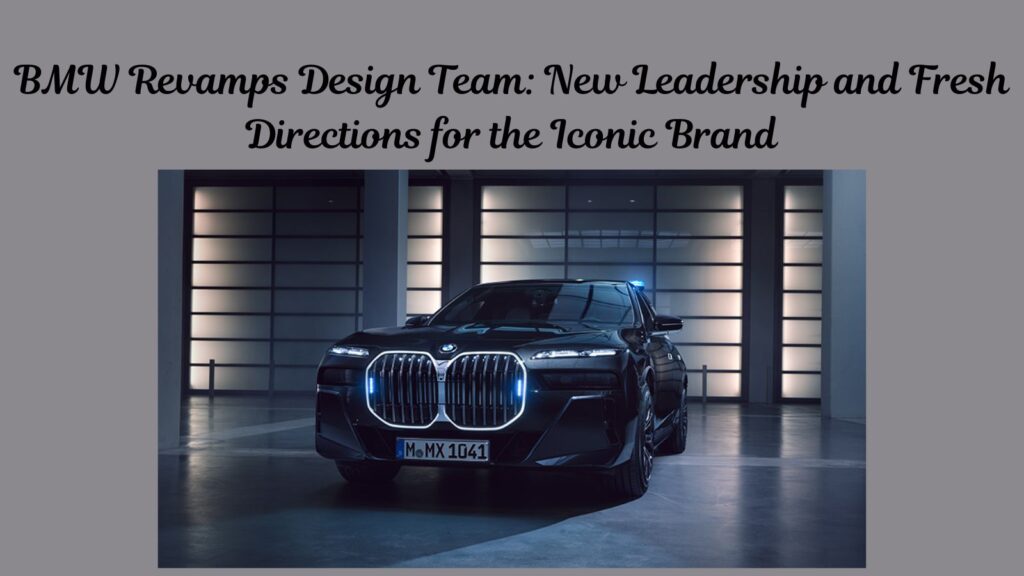BMW Revamps Design Team: New Leadership and Fresh Directions for the Iconic Brand
BMW, a brand synonymous with luxury, performance, and cutting-edge design, is taking its design philosophy to new heights. BMW is shaking up its leadership and redesigning its team. This sets the stage for a smarter and more modern approach to design. In this article, we’ll dive into the key leadership changes, the direction BMW is headed in, and what it means for their future models.
Overview of BMW’s New Design Vision:
BMW has long been known for its iconic vehicles that blend performance, luxury, and innovation. BMW is changing its design strategy. The automotive world is evolving with new technology, changing tastes, and rising competition. This helps them stay a leader in the industry. This transformation is not just cosmetic; it’s about setting a vision that will influence the brand’s aesthetic for years to come.
BMW is changing its design department as it focuses on electric and sustainable vehicles. Innovative designs are now at the forefront. Under the new leadership, BMW aims to combine its rich history with the demands of a rapidly changing automotive market.

Leadership Shakeup: Who’s Leading BMW’s New Design Team?
BMW’s design overhaul is marked by several key leadership changes. These people have years of experience. They think creatively and are dedicated to boosting BMW’s brand identity. Here’s a breakdown of the new leaders at the helm of BMW’s design transformation:
Maximilian Missoni – Leading Luxury and Alpina Models
Maximilian Missoni, the former Head of Design at Polestar, is a major new addition to the team. Missoni, known for his award-winning designs at Polestar and his work at Volvo, will now lead the design for BMW’s luxury and Alpina models.
Why it matters:
- Missoni’s design legacy features Polestar’s sleek, modern look and cutting-edge electric vehicle designs. He played a major role in shaping the Polestar 1 and 2, which are lauded for their sleek, forward-thinking designs.
- His design philosophy emphasizes simplicity, clean lines, and sustainability. These elements align with BMW’s push for electric vehicles (EVs) and a more refined design language that caters to a more discerning customer.
- Luxury will stay central to BMW’s brand identity. However, the focus will shift to a more elegant and sophisticated style. This change meets modern consumers’ needs for sustainability and advanced technology.
Adrian van Hooydonk – BMW’s Head of Design
Adrian van Hooydonk, who has served as BMW Group’s Head of Design for years, will continue to oversee the design department. Van Hooydonk’s leadership has guided the brand in creating key models. These include the BMW iX and BMW i4. Both cars are crucial for the company’s move into electric mobility.
- He plays a key role as the head of the design team. He guides the overall vision and works closely with the new leaders of each subdivision.
Domagoj Dukec – Moving to Rolls-Royce
Domagoj Dukec, who previously served as the Head of BMW Design Studio, will transition to a new role at BMW’s Rolls-Royce. Dukec is known for his bold, innovative designs, but his tenure at BMW was not without controversy. Many of his designs, including the BMW 4 Series and X7, drew mixed reactions for their aggressive, bold styling.
- Dukec’s move to Rolls-Royce brings a classic, elegant style. This change fits the luxury brand’s identity and makes design choices less divisive.
Additional Leadership Changes at BMW
Oliver Heilmer – New Role Overseeing BMW’s Compact and M Models
Oliver Heilmer, the current head of design at Mini, will now oversee design for BMW’s compact and mid-size models as well as BMW M models. Heilmer’s 20 years of experience at BMW Group will bring a refined, sporty edge to the design of BMW’s performance models.
- He knows BMW’s M Division well. This will help keep the brand’s sporty, high-performance cars looking dynamic. They will include features like aerodynamic design and driver-focused interiors.
Holger Hampf – Leading MINI Design
Holger Hampf, who previously worked at BMW Group Designworks, will take over as the new head of design at Mini. He leads the design of Mini’s small, iconic cars. He focuses on personalization, small-car charm, and modern tech.
New Roles and Expanded Focus
Additional changes in BMW’s design team include:
- Anders Warming, formerly Rolls-Royce’s Head of Design, will now manage Advanced Design topics and the BMW Group Designworks subsidiary.
- Claudia Braun will lead a new cross-brand department focusing on Colour and Material Design for BMW, MINI, and Rolls-Royce. With experience from Porsche, Daimler, and Volvo, Braun is set to bring a fresh perspective to the design process.
Key Changes in BMW’s Design Focus and New Roles
In addition to leadership changes, other key developments are shaping BMW’s design strategy:
Anders Warming – Leading Advanced Design and BMW Group Designworks
Anders Warming, the ex-Head of Design at Rolls-Royce, will now handle Advanced Design at BMW. He will also oversee the BMW Group Designworks subsidiary. Warming’s time at Rolls-Royce and his knack for luxury design will elevate BMW’s advanced design efforts. This will help the brand lead in sustainable vehicle design, aerodynamics, and future mobility solutions.
Claudia Braun – Colour and Material Design
Claudia Braun, a design expert from Porsche, Daimler, and Volvo, will head a new team. This department will focus on Colour and Material Design for BMW, Mini, and Rolls-Royce. This department will offer new ideas on materials, finishes, and colors for BMW Group brands. It will focus on what consumers want in luxury and personalization.
BMW’s Design Transformation: What Does This Mean for the Future?
BMW’s big shake-up of its design team goes beyond just new leaders. It shows how the brand’s style is evolving to fit today’s car market. These changes focus on luxury, sustainability, and performance. They aim to align the brand with future trends. This will help BMW stay competitive in the growing electric vehicle market.
The company shows its commitment to sustainability through electric and hybrid models. These vehicles feature innovative and minimalist designs. In the next few years, BMW’s design will continue to evolve. We’ll see a mix of smart technology and elegant, timeless looks.
Real-Time Example: BMW’s i4 and iX electric vehicles have already set the stage for a more sustainable design direction. The bold, sculpted exterior lines and sleek, high-tech interiors show a new, eco-friendly design approach. This shift will shape future models under Maximilian Missoni’s leadership.
Fun Fact:
BMW’s design history has several key eras. The Chris Bangle era stood out for its bold and modern designs. Recently, the brand has focused on fluid and aerodynamic shapes, especially in the i-series and M-series cars. The new leadership team aims to create a timeless design language that respects the brand’s roots while pushing it forward into a new era.
Frequently Asked Questions (FAQs)
BMW is changing its design team. This will bring in new ideas and improve its design style. The goal is to better match the move toward electric and sustainable cars. Maximilian Missoni’s leadership will enhance the brand’s luxury and performance models.
Maximilian Missoni, from Polestar, will bring a new, minimalist style to BMW. He will focus on clean lines, eco-friendly materials, and a fresh design look.
BMW will keep focusing on luxury, sustainability, and performance. They will also emphasize electric vehicles and new technology. Expect a shift toward timeless designs that blend elegance with innovation.
Key leaders are:
Maximilian Missoni, Head of Design for BMW Luxury and Alpina models.
Oliver Heilmer, overseeing BMW’s compact, mid-size, and M models.
Anders Warming, managing Advanced Design.
Sustainability is important. There’s more focus on eco-friendly materials, electric vehicles, and simple designs. These choices help reduce environmental impact.
China Reaches Milestone in Electric Vehicle Sales
Conclusion: A New Era for BMW’s Design Identity
BMW is changing its design department. This shift marks a bold move toward a modern look. It will redefine the company’s identity in the years to come. BMW is welcoming Maximilian Missoni from Polestar and making other key leadership changes. This move aims to help BMW tackle the challenges of an electric future. At the same time, the brand wants to keep its strong reputation for luxury, performance, and innovation.
BMW will keep focusing on sustainability, advanced materials, and new technology. This focus will guide their design and help the brand stay a leader in the automotive industry. Will these changes create a design language that appeals to BMW fans and eco-friendly buyers?
As BMW embarks on this exciting new chapter, all eyes will be on the next generation of vehicles, and how the company’s design evolution will unfold.






